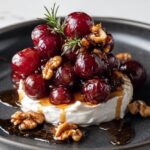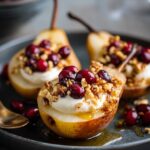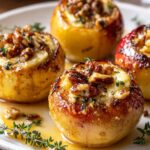Roasted Butternut Squash Rounds with Ricotta and Pecan Crumble: An Elegant Fall Appetizer
These Roasted Butternut Squash Rounds with Ricotta and Pecan Crumble offer a stunning presentation that will impress your guests immediately. Imagine perfectly caramelized rounds of squash topped with creamy ricotta, a sweet-tart cranberry pop, and a crunchy pecan topping. This dish beautifully captures the essence of autumn on a single plate. Furthermore, it serves as an elegant appetizer for holiday dinners or a satisfying vegetarian main course.
The beauty of these Roasted Butternut Squash Rounds with Ricotta and Pecan Crumble lies in their harmonious balance of flavors and textures. Each component plays a crucial role in creating a memorable culinary experience. Consequently, you get sweet, savory, creamy, and crunchy elements in every single bite. This recipe transforms simple, seasonal ingredients into an extraordinary dish that feels both rustic and refined.
Preparing these Roasted Butternut Squash Rounds with Ricotta and Pecan Crumble requires minimal effort for maximum impact. Surprisingly, this impressive-looking dish comes together in just about 40 minutes from start to finish. Moreover, it uses ingredients that are readily available during the fall and winter months. Whether you are hosting a formal gathering or simply want to elevate your weeknight dinner, this recipe delivers exceptional results every time.
Quick Recipe Highlights
- Flavor Profile: These Roasted Butternut Squash Rounds with Ricotta and Pecan Crumble deliver a sophisticated sweet and savory combination. The natural sweetness of the roasted squash perfectly complements the tangy ricotta and sharp Parmesan. Additionally, the dried cranberries provide a burst of tartness that cuts through the richness.
- Texture: You will experience a delightful contrast of textures in every bite. The tender, caramelized squash provides a soft base, while the creamy ricotta adds smoothness. Meanwhile, the pecan crumble offers a satisfying crunch that elevates the entire dish.
- Aroma: As these Roasted Butternut Squash Rounds with Ricotta and Pecan Crumble cook, your kitchen will fill with warm, comforting aromas. The scent of roasting squash mingles with toasting pecans and fragrant rosemary. Ultimately, this creates an inviting atmosphere that promises a delicious meal.
- Visual Appeal: The presentation of these Roasted Butternut Squash Rounds with Ricotta and Pecan Crumble is truly stunning. The vibrant orange squash rounds create a beautiful canvas for the white ricotta, red cranberries, and brown pecan crumble. Consequently, this dish looks as impressive as it tastes.
- Skill Level Needed: This recipe is accessible to cooks of all experience levels. Basically, you only need basic knife skills for slicing the squash and simple mixing techniques for the toppings. Therefore, even beginner cooks can achieve restaurant-quality results.
- Special Equipment: You only require standard kitchen tools to make these Roasted Butternut Squash Rounds with Ricotta and Pecan Crumble. Specifically, a baking sheet, parchment paper, a sharp knife, and a mixing bowl are all you need. Fortunately, no specialized equipment is necessary.
Recipe Overview
- Difficulty Level: These Roasted Butternut Squash Rounds with Ricotta and Pecan Crumble are remarkably easy to prepare. The steps involve simple slicing, mixing, and roasting techniques that anyone can master. Additionally, the assembly requires no special culinary skills. Ultimately, this recipe proves that impressive dishes don’t need to be complicated.
- Category: These versatile Roasted Butternut Squash Rounds with Ricotta and Pecan Crumble fit multiple meal categories. They work beautifully as an appetizer, side dish, or even a light vegetarian main course. Furthermore, they can be served at everything from casual family dinners to formal holiday gatherings.
- Cuisine: This recipe draws inspiration from contemporary American cuisine with Mediterranean influences. The use of ricotta and Parmesan cheese nods to Italian traditions, while the pecan crumble reflects Southern American ingredients. However, the overall combination creates a modern fusion dish that celebrates seasonal produce.
- Cost: Preparing these Roasted Butternut Squash Rounds with Ricotta and Pecan Crumble is surprisingly economical. Butternut squash is inexpensive during autumn months, and the other ingredients are pantry staples. Moreover, a single squash yields multiple servings, making this a cost-effective choice for entertaining.
- Season: These Roasted Butternut Squash Rounds with Ricotta and Pecan Crumble are perfect for fall and winter months. Butternut squash reaches its peak sweetness during autumn, and the warm spices complement cooler weather perfectly. Consequently, this dish has become a seasonal favorite for many home cooks.
- Occasion: This versatile recipe suits numerous occasions throughout the holiday season and beyond. It makes an elegant starter for Thanksgiving or Christmas dinner, a beautiful addition to a brunch spread, or a special weeknight treat. Additionally, it’s impressive enough for dinner parties yet simple enough for casual meals.
Why You’ll Love This Recipe
The exceptional flavor combination will make these Roasted Butternut Squash Rounds with Ricotta and Pecan Crumble an instant favorite. Each element complements the others perfectly, creating a harmonious balance on your palate. The sweet, caramelized squash base provides a wonderful foundation for the creamy, tangy ricotta mixture. Meanwhile, the tart cranberries cut through the richness, and the crunchy pecan topping adds the final textural contrast. Every bite delivers multiple sensations that will keep you coming back for more.
Convenience is another significant advantage of these Roasted Butternut Squash Rounds with Ricotta and Pecan Crumble. The preparation is straightforward and requires no complicated techniques or hard-to-find ingredients. You can easily assemble the components while the squash roasts, making efficient use of your time in the kitchen. Furthermore, the dish can be partially prepared in advance, reducing last-minute stress when entertaining. This makes it an ideal choice for busy hosts who want to serve something impressive without spending hours in the kitchen.
Nutritional benefits add to the appeal of these Roasted Butternut Squash Rounds with Ricotta and Pecan Crumble. Butternut squash is packed with vitamins A and C, fiber, and antioxidants, supporting immune health and digestion. Ricotta provides high-quality protein and calcium, while pecans offer healthy fats and additional antioxidants. Consequently, this dish not only tastes indulgent but also provides substantial nutritional value. It’s a perfect example of how delicious food can also be nourishing.
The social and entertaining value of these Roasted Butternut Squash Rounds with Ricotta and Pecan Crumble cannot be overstated. Their beautiful appearance immediately elevates any table setting and sparks conversation among guests. The individual portions make serving easy and elegant, whether you’re hosting a sit-down dinner or a cocktail party. Additionally, the recipe easily scales up or down to accommodate different group sizes. This versatility makes it a reliable go-to recipe for various social occasions.
Cost-effectiveness and accessibility make these Roasted Butternut Squash Rounds with Ricotta and Pecan Crumble practical for regular preparation. Butternut squash is inexpensive, especially during its peak season, and the other ingredients are typically pantry staples. You can often find sales on ricotta and nuts, making this dish even more budget-friendly. Moreover, the ingredients are readily available at most grocery stores year-round. This accessibility means you can enjoy this gourmet-tasting dish whenever the craving strikes.
Historical Background and Cultural Significance
The origin of using squash in cooked dishes dates back thousands of years to indigenous cultures throughout the Americas. Native American tribes cultivated various squash varieties, including ancestors of modern butternut squash, as part of the “Three Sisters” agricultural system alongside corn and beans. These versatile vegetables provided essential nutrition through harsh winters when other food sources were scarce. The practice of roasting squash developed as a simple, effective cooking method that enhanced its natural sweetness. European settlers later adopted squash into their culinary traditions, incorporating dairy and other Old World ingredients.
Cultural significance of squash-based dishes varies across different culinary traditions. In Italian cuisine, squash often appears paired with ricotta in ravioli and other stuffed pasta dishes, creating a classic flavor combination. Southern American cooking frequently features pecans in both sweet and savory applications, taking advantage of this native nut. The combination of these elements in Roasted Butternut Squash Rounds with Ricotta and Pecan Crumble represents a fusion of culinary traditions. This blending of influences reflects the evolving nature of modern American cuisine.
The evolution of this specific recipe follows broader food trends emphasizing vegetable-forward dishes and beautiful presentation. As home cooks and professional chefs alike sought ways to make vegetables the star of the plate, creative preparations like these rounds gained popularity. The individual portion style aligns with contemporary dining preferences for personalized plates and shareable appetizers. Additionally, the focus on seasonal, whole ingredients responds to growing consumer interest in understanding food sources. This recipe perfectly captures current culinary values while honoring traditional flavor combinations.
Regional variations of similar dishes appear throughout squash-growing regions worldwide. In France, roasted squash might be served with goat cheese and hazelnuts, while in the Mediterranean, olive oil, garlic, and herbs would dominate. The cranberry element in this recipe particularly reflects North American traditions, where this native fruit has long been used in both sweet and savory contexts. Some modern variations might include maple syrup instead of honey or different nuts like walnuts or pistachios. This adaptability demonstrates how core concepts can be tailored to local ingredients and preferences.
Ingredient Deep Dive
Butternut squash serves as the foundation for these elegant rounds, providing both structural integrity and sweet, earthy flavor. This winter squash variety originated in North America and has become popular worldwide for its versatile culinary applications and excellent storage qualities. Nutritionally, it’s rich in vitamin A, vitamin C, potassium, and fiber, supporting eye health, immune function, and digestion. When selecting butternut squash, choose ones that feel heavy for their size with firm, matte skin free of soft spots. Store whole squash in a cool, dark place for up to three months, but once cut, wrap tightly and refrigerate for up to five days.
Ricotta cheese brings creamy texture and mild tanginess that balances the squash’s sweetness. This fresh Italian cheese traditionally made from whey leftover from other cheese production has a light, slightly grainy texture that melts beautifully when heated. It provides high-quality protein, calcium, and phosphorus while being lower in fat and sodium than many other cheeses. Look for fresh ricotta with a clean, milky scent and moist appearance; avoid any with excessive liquid or sour odor. For storage, keep ricotta refrigerated in its original container and use within five days of opening. If unavailable, cottage cheese (strained) or goat cheese make suitable substitutes.
Pecans contribute the essential crunchy element in the crumble topping, along with rich, buttery flavor. Native to North America, pecans have been foraged and cultivated for centuries, particularly in the southern United States where they remain an important agricultural product. They’re packed with heart-healthy monounsaturated fats, antioxidants, and various vitamins and minerals including manganese and copper. Select pecans that feel plump and uniform in color without visible oiliness or dark spots, which indicate age. Store pecans in an airtight container in the refrigerator or freezer to prevent rancidity. Walnuts or almonds can substitute if pecans are unavailable, though the flavor profile will change slightly.
Dried cranberries provide vibrant color and tart contrast that cuts through the dish’s richness. While fresh cranberries have long been used by Native Americans, the dried version became popular more recently as a convenient, shelf-stable ingredient. They contain various antioxidants and fiber, though commercial dried cranberries often include added sugars. Look for versions with minimal added sweeteners or consider drying your own for maximum control. Store dried cranberries in a cool, dark place in sealed containers. Chopped dried apricots, cherries, or golden raisins can work as alternatives depending on your flavor preferences.
Parmesan cheese adds savory depth and umami notes that enhance all other flavors in the dish. This hard, aged Italian cheese has a granular texture and complex, nutty flavor that intensifies when heated. Authentic Parmigiano-Reggiano offers superior flavor but domestic Parmesan works well too. Nutritionally, it’s rich in protein, calcium, and phosphorus while being naturally low in lactose. Look for cheese that feels firm and heavy with a natural rind rather than pre-grated versions which often contain anti-caking agents. Wrap Parmesan tightly in parchment or wax paper and store in the refrigerator. For vegetarian versions, seek out cheeses made with vegetable rennet.
Common Mistakes to Avoid
- Cutting squash rounds unevenly leads to inconsistent cooking. Some pieces may burn while others remain undercooked if thickness varies significantly. Always use a sharp knife and measure thickness to ensure uniform roasting. This attention to detail guarantees perfect texture throughout.
- Overcrowding the baking sheet prevents proper caramelization. When squash pieces touch each other, they steam rather than roast. Consequently, you miss the delicious browned edges and concentrated flavor. Use two baking sheets if necessary to provide adequate space.
- Underseasoning the squash before roasting results in bland final dish. Butternut squash needs generous seasoning to enhance its natural sweetness. Don’t be shy with salt, pepper, and olive oil at this crucial stage. Proper seasoning makes all the difference.
- Using watery ricotta creates a soggy topping that compromises texture. Always drain ricotta well if it appears liquid. Alternatively, you can strain it through cheesecloth for thicker consistency. This extra step ensures your topping stays creamy rather than wet.
- Burning the pecan crumble ruins its flavor and texture. Nuts can go from perfectly toasted to burnt quickly in the oven. Watch carefully during the last few minutes of baking. Remove immediately when golden brown and fragrant.
- Skipping the resting time makes assembly messy. Hot squash can cause ricotta to slide off when topped immediately. Let rounds cool slightly so toppings adhere properly. This patience improves both presentation and eating experience.
- Overloading with toppings overwhelms the delicate squash flavor. While generous portions seem appealing, balance is crucial. Each component should complement rather than dominate. Moderate application ensures harmonious flavor integration.
- Using stale nuts or spices diminishes overall flavor impact. Pecans turn rancid relatively quickly, and spices lose potency over time. Always taste ingredients before using, especially if they’ve been stored awhile. Fresh ingredients elevate the final result significantly.
Essential Techniques
Properly roasting butternut squash requires understanding how heat transforms this sturdy vegetable. The process caramelizes natural sugars, developing deeper flavor while creating tender texture that still holds its shape. To achieve perfect roasting, ensure your oven is fully preheated and use enough oil to coat each round thoroughly. Arrange pieces in a single layer with space between them to allow hot air circulation rather than steaming. Visual cues for perfectly roasted squash include golden brown edges and easily pierced flesh with a fork. Under-roasted squash will be difficult to pierce, while over-roasted pieces may collapse or blacken.
Creating the perfect pecan crumble involves toasting nuts to develop flavor while maintaining crunch. The technique combines chopped pecans with breadcrumbs, Parmesan, and seasonings bound with olive oil. The mixture should feel slightly moist but not greasy, clumping loosely when squeezed. Spread it evenly on the baking sheet to ensure uniform browning, stirring occasionally if needed for even color. Properly toasted crumble appears golden brown and releases a nutty aroma. Watch carefully during the final minutes since nuts can burn quickly. The crumble should feel crisp when cooled, signaling successful toasting.
Preparing the ricotta mixture demands balance between creaminess and stability. Combining ricotta with Parmesan, lemon zest, and seasonings creates a flavorful spread that holds its shape when baked. Draining excess liquid from the ricotta beforehand prevents a watery result that could make squash soggy. The mixture should be thick enough to hold peaks when spooned but spreadable without tearing the squash underneath. Overmixing can make the texture gummy, so fold ingredients gently until just combined. The perfect ricotta topping will warm through without separating or becoming watery during final baking.
Assembling the rounds requires strategic layering for optimal texture and visual appeal. Start with completely roasted squash rounds as your stable base, then add ricotta mixture using a small spoon or piping bag for neat portions. Sprinkle cranberries evenly across the surface, followed by generous pecan crumble that provides textural contrast. Work efficiently once you begin assembly to maintain optimal serving temperature. The finished rounds should show all components visibly while maintaining structural integrity. Proper assembly ensures each bite contains all elements in harmonious proportion.
Pro Tips for Perfect Roasted Butternut Squash Rounds
Select medium-sized squash with uniform width for consistently sized rounds. Larger squash often have bulbous bottoms that create awkward shapes when sliced. The straight-necked varieties work particularly well for this application. This careful selection simplifies preparation and improves presentation.
Use a sharp chef’s knife or serrated bread knife for clean squash slices. Dull blades can slip and cause injury while crushing rather than cutting the firm flesh. A sharp knife glides through smoothly, creating even rounds. This simple tool maintenance significantly improves results.
Toss squash rounds with oil and seasonings in a large bowl rather than on the baking sheet. This method ensures even coating without torn edges from excessive handling. Gently lift pieces onto the prepared sheet afterward. This technique guarantees consistent flavor and browning.
Rotate baking sheets halfway through roasting if your oven has hot spots. Most home ovens cook unevenly, causing some pieces to brown faster than others. Switching rack positions promotes uniform caramelization. This attention to oven quirks produces professional results.
Toast extra pecan crumble to use as a salad or soup topping. The mixture stores well in an airtight container for several days. Having it prepared saves time for future meals. This efficiency makes kitchen time more productive.
Let roasted squash cool slightly before adding toppings to prevent sliding. Hot surfaces can melt the rictoo quickly, causing toppings to slip off. Five minutes of cooling makes assembly much easier. This patience improves both presentation and eating experience.
Garnish with fresh herbs just before serving for vibrant color and freshness. Rosemary, thyme, or sage leaves add visual appeal and aromatic complexity. The green contrast makes the dish more photographable. This final touch elevates the overall impression.
Serve on a warmed platter to maintain ideal eating temperature. Cold surfaces can chill the rounds quickly, diminishing flavor and texture. A quick warm-up in the oven prepares serving dishes perfectly. This consideration shows attention to detail that guests appreciate.
Variations and Adaptations
Regional variations allow you to customize these rounds based on local ingredients and culinary traditions. Mediterranean versions might feature feta instead of ricotta with olives and oregano replacing cranberries and rosemary. Southern adaptations could use pimento cheese and toasted pecans with a bourbon glaze. Southwest interpretations might incorporate cotija cheese, pepitas, and chili powder for spicy warmth. Asian-inspired versions could utilize miso-seasoned squash with tofu ricotta and sesame-ginger crumble. These regional twists demonstrate the recipe’s incredible adaptability while maintaining its core concept of topped squash rounds.
Seasonal adaptations keep this dish exciting throughout the year by incorporating available produce. Spring versions might use delicata squash with herbed goat cheese and lemon zest alongside fresh peas or asparagus tips. Summer adaptations could feature pattypan squash with basil pesto ricotta and sun-dried tomato crumble. Autumn remains perfect for the classic butternut version with cranberries and pecans. Winter variations might incorporate kabocha squash with blue cheese and walnut crumble with pomegranate arils. These seasonal rotations ensure the dish always feels fresh and appropriate for current conditions.
Dietary modifications make this recipe accessible to various eating preferences and restrictions. Vegan versions can use cashew ricotta (blended soaked cashews with nutritional yeast and lemon) and omit Parmesan from the crumble. Gluten-free adaptations simply require certified gluten-free breadcrumbs or rolled oats in the topping. Lower-carb versions might use almond flour and extra nuts instead of breadcrumbs in the crumble mixture. Dairy-free options can utilize tofu-based spreads or commercially available plant-based ricotta alternatives. These modifications ensure everyone can enjoy this delightful dish regardless of dietary needs.
Flavor variations provide endless opportunities for creativity while maintaining the preparation method. Savory options might include caramelized onion and thyme ricotta with bacon crumble or mushroom duxelles with Gruyère cheese. Sweet interpretations could feature maple-roasted squash with cinnamon-spiced ricotta and candied pecan crumble. Herb-focused versions might highlight different combinations like sage-brown butter ricotta with hazelnuts or tarragon-lemon ricotta with pistachios. Spicy adaptations could incorporate chipotle-seasoned squash with pepper jack cheese and pumpkin seed crumble. These flavor explorations keep the concept exciting through repeated preparations.
Serving and Presentation Guide
Plating techniques significantly impact how guests perceive these elegant squash rounds. For individual servings, arrange three rounds slightly overlapping on warmed appetizer plates with a drizzle of reduced balsamic or honey around the plate. Family-style presentation works beautifully on a large wooden board or slate platter with rounds arranged in concentric circles. Create height variation by stacking some rounds or propping them against a small garnish pile. Always wipe plate edges clean before serving for a professional appearance. These presentation details transform simple ingredients into restaurant-quality dishes.
Garnishing ideas add final visual appeal and flavor accents that complement the main components. Fresh herb sprigs like rosemary, thyme, or sage provide greenery contrast and aromatic enhancement. Microgreens or baby arugula scattered around the plate introduce freshness and peppery notes. Edible flowers like nasturtiums or pansies create stunning visual impact for special occasions. Additional crumble sprinkles around the plate reinforce the textural element while filling empty spaces. A final dusting of Parmesan cheese or paprika adds color contrast and flavor depth. These garnishes should enhance rather than overwhelm the carefully constructed rounds.
Traditional accompaniments balance the rich, savory-sweet profile of these squash rounds. Bitter greens salads with citrus vinaigrette cut through the richness while adding refreshing contrast. Creamy soups like potato leek or mushroom provide comforting warmth that complements the autumn flavors. Roasted meats like herb-crusted chicken or pork tenderloin create a balanced meal with protein addition. Hearty grains like farro, wild rice, or quinoa pilaf absorb flavors while extending the dish economically. These pairings create well-rounded menus that highlight the squash rounds as either starter or side component.
Modern serving suggestions adapt this dish to contemporary dining trends and occasions. For cocktail parties, prepare miniature versions using smaller squash varieties or cut larger rounds into quarters for bite-sized portions. Brunch applications might include a poached egg on top for added protein and sauciness. Charcuterie board inclusions position the rounds among cured meats, cheeses, and other vegetable elements for grazing-style meals. Salad toppers transform the rounds into substantial meal components when placed atop mixed greens. These innovative applications demonstrate the recipe’s versatility beyond traditional serving contexts.
Wine and Beverage Pairing
Wine pairings should complement the sweet, savory, and creamy elements of these squash rounds. Off-dry white wines like Riesling or Gewürztraminer balance the squash’s sweetness while cutting through the ricotta’s richness. Medium-bodied reds with low tannins such as Pinot Noir or Beaujolais provide fruitiness without overwhelming the delicate flavors. Orange wines with their oxidative notes and texture bridge the gap between white and red characteristics beautifully. Sparkling options like Prosecco or Cava refresh the palate between bites with their acidity and effervescence. These selections enhance rather than compete with the dish’s complex flavor profile.
Non-alcoholic alternatives provide sophisticated options for all guests regardless of preference. Sparkling apple cider offers autumnal sweetness and bubbles that mirror sparkling wine pairings. Craft ginger beer with its spicy warmth complements the squash’s sweetness while cutting through richness. Herbal teas like rosemary-thyme infusion served chilled provide botanical notes that echo the dish’s seasoning. Virgin spritzes with cranberry juice, lime, and soda water reference the cranberry component while refreshing the palate. These thoughtful non-alcoholic options ensure every guest enjoys a complete dining experience.
Coffee and tea pairings work wonderfully when serving these rounds for brunch or late afternoon occasions. Medium-roast coffee with nutty or chocolate notes enhances the pecan crumble without bitterness. Chai tea’s warming spices complement the autumn flavors while the creamy preparation mirrors the ricotta component. Green tea with its grassy notes provides cleansing contrast to the rich ingredients. Earl Grey’s bergamot aroma offers floral complexity that lifts the entire eating experience. These hot beverage pairings create cozy, complete meals perfect for cooler weather.
Temperature considerations ensure beverages complement rather than conflict with the dish. White and sparkling wines should be properly chilled but not ice-cold to allow flavors to emerge. Red wines served slightly cooler than room temperature prevent alcohol from overwhelming delicate squash flavors. Non-alcoholic options benefit from serving temperature appropriate to their type—chilled for juices and spritzes, hot for teas and coffee. Proper temperature management maximizes how beverages interact with food flavors. This attention to detail separates good pairings from exceptional ones.
Storage and Shelf Life
Storage methods vary depending on whether you’re saving assembled rounds or component parts. Unassembled roasted squash rounds keep well in an airtight container in the refrigerator for 3-4 days. The pecan crumble stores separately in a sealed container at room temperature for up to one week. Ricotta mixture should be stored in its own container and used within 3 days. Assembled rounds don’t store well as the squash becomes soggy from the toppings. Understanding these different storage requirements helps maintain quality when preparing components in advance.
Temperature requirements protect both food safety and quality during storage. Refrigerate all components containing dairy or cooked vegetables at or below 40°F to prevent bacterial growth. The pecan crumble benefits from cool, dark storage but refrigeration isn’t necessary if used within one week. Freezing isn’t recommended for assembled rounds or ricotta mixture as textures suffer significantly. Squash rounds alone can be frozen on a baking sheet then transferred to freezer bags, though they may become softer upon thawing. Proper temperature management ensures ingredients remain safe and delicious.
Container recommendations prevent moisture loss or absorption that compromises texture. Glass containers with tight-fitting lids work best for squash rounds and ricotta mixture. For the dry pecan crumble, airtight jars or plastic containers protect against humidity and staleness. If stacking squash rounds in containers, separate layers with parchment paper to prevent sticking. Always cool components completely before storage to prevent condensation that creates sogginess. Appropriate containers maintain the distinct textures that make this dish special.
Signs of spoilage include off odors, visible mold, or significant texture changes. Ricotta that smells sour or develops liquid separation should be discarded immediately. Squash rounds that become slimy or develop dark spots indicate bacterial growth. Pecan crumble that smells rancid or tastes bitter has oxidized and lost quality. Assembled rounds that have been refrigerated more than a day often become unpleasantly watery. When in doubt, remember the adage “when in doubt, throw it out” rather than risking foodborne illness.
Make Ahead Strategies
Prep timeline planning maximizes efficiency when serving these rounds for entertaining. Two days ahead, prepare the pecan crumble and store at room temperature. One day ahead, roast the squash rounds and refrigerate in single layers between parchment. The same day, prepare the ricotta mixture and refrigerate until one hour before assembly. Two hours before serving, bring components to room temperature for optimal texture. Thirty minutes before serving, assemble rounds and warm briefly in a 350°F oven. This staggered approach minimizes last-minute work while ensuring fresh, vibrant results.
Storage between steps maintains quality when preparing components in advance. Roasted squash rounds should be cooled completely then stored in single layers separated by parchment paper in airtight containers. The ricotta mixture benefits from being stored in a fine-mesh strainer over a bowl to drain excess liquid. The pecan crumble should be stored in paper towel-lined containers to absorb any residual oils. All components should be brought to room temperature before assembly to prevent condensation. These specific storage methods preserve the distinct textures essential to the dish’s success.
Quality impact assessment helps determine which elements hold up best when prepared ahead. The pecan crumble maintains excellent texture and flavor for up to one week when stored properly. Roasted squash rounds experience minimal quality loss when refrigerated for 2-3 days before serving. The ricotta mixture is best prepared the same day as its texture changes with extended refrigeration. Assembly should always happen shortly before serving to prevent sogginess. Understanding these variables allows you to plan preparation according to your schedule while maintaining standards.
Scaling Instructions
Halving the recipe works beautifully for smaller households or intimate meals. Use a smaller butternut squash or save the remaining squash for other uses. Reduce all other ingredients proportionally, though you might use slightly more than half the olive oil for proper coating. Baking time may decrease by 2-3 minutes due to better air circulation with fewer rounds. The pecan crumble can still be made in full batch and stored for future use. These adjustments allow you to enjoy this dish without excessive leftovers.
Doubling or tripling the recipe requires practical considerations for successful execution. Use multiple baking sheets rotated between oven racks halfway through cooking for even browning. You may need to roast in batches if your oven cannot accommodate multiple sheets effectively. Increase seasoning proportionally but taste as you go since measurement precision becomes more critical at larger volumes. Consider preparing components in separate bowls to ensure thorough mixing. Allow extra time for preparation and assembly when working with larger quantities. These precautions prevent quality compromise when cooking for crowds.
Equipment adjustments become necessary when significantly increasing recipe yield. Additional baking sheets, mixing bowls, and storage containers ensure organized workflow. Half-sheet pans maximize oven space efficiency compared to smaller baking sheets. Commercial cooling racks accommodate more rounds without stacking or crowding. Piping bags with large tips speed up ricotta application for high-volume assembly. These equipment considerations streamline the process when preparing larger batches for events or meal prep.
Nutritional Deep Dive
Macro breakdown reveals a balanced nutritional profile that fits various eating patterns. Each serving provides approximately 15 grams of carbohydrates primarily from the squash, offering sustained energy release. The 8 grams of protein mainly from ricotta and Parmesan supports muscle maintenance and satiety. Approximately 12 grams of fat comes largely from heart-healthy sources like olive oil and pecans. This balance makes the dish satisfying without being overly heavy. The fiber content from squash and nuts promotes digestive health and blood sugar stability.
Micronutrient analysis highlights the impressive vitamin and mineral content of these squash rounds. Butternut squash delivers exceptionally high vitamin A as beta-carotene, supporting vision, immune function, and skin health. The combination provides significant vitamin C for collagen production and antioxidant protection. Pecans contribute manganese and copper for enzyme function and energy production. Ricotta and Parmesan offer calcium and phosphorus for bone health. These micronutrients work synergistically to support overall wellbeing.
Health benefits extend beyond basic nutrition to various aspects of wellness. The orange pigment in squash indicates high antioxidant content that fights inflammation and oxidative stress. Monounsaturated fats from olive oil and pecans support cardiovascular health and cholesterol balance. The fiber combination promotes healthy gut microbiome and regular digestion. Anti-inflammatory compounds in rosemary and black pepper provide additional protective effects. These benefits make the dish both delicious and genuinely nourishing.
Dietary Adaptations
Gluten-free adaptation simply requires using certified gluten-free breadcrumbs or alternatives like crushed gluten-free crackers or rolled oats. Check that all other ingredients including spices come from gluten-free facilities if cross-contamination is a concern. The basic recipe contains no inherent gluten sources beyond potential breadcrumb issues. This straightforward modification makes the dish accessible to those with celiac disease or gluten sensitivity.
Dairy-free version replaces ricotta with blended firm tofu, cashew cream, or commercial plant-based ricotta alternatives. Nutritional yeast can provide the cheesy flavor typically from Parmesan in both the ricotta mixture and crumble. Use olive oil rather than butter in the crumble for binding. Many plant-based Parmesan alternatives work well sprinkled over the finished dish. These substitutions create a satisfying dairy-free version that maintains the original concept.
Vegan adaptation combines the dairy-free modifications with egg-free breadcrumbs if used in the crumble. Ensure any sweeteners like honey are replaced with maple syrup or agave nectar. Check that all components including breadcrumbs contain no hidden animal products. The result provides the same elegant presentation and textural contrast without animal ingredients. This adaptation makes the dish inclusive for all dietary preferences.
Troubleshooting Guide
Texture issues commonly stem from improper squash preparation or storage. If rounds become mushy, you may have overcrowded the baking sheet or sliced pieces too thin. Soggy bottoms often result from assembling too far in advance or using overly watery ricotta. Tough squash indicates undercooking, while collapsed pieces signal overroasting. To salvage oversoft squash, consider mashing with the ricotta mixture and serving as a dip. Understanding these texture relationships helps prevent and address common problems.
Flavor balance problems typically involve underseasoning or incompatible ingredient qualities. Bland results usually need more salt during the initial seasoning stage rather than at the end. Overly sweet outcomes might benefit from extra black pepper or rosemary to counterbalance. If ricotta tastes flat, increase lemon zest or Parmesan in the mixture. Bitter notes from burnt components require careful removal of affected portions. These adjustments restore harmony to the flavor profile.
Temperature problems affect both food safety and eating experience. If rounds cool too much before serving, briefly warm in a 350°F oven for 5-7 minutes. Overheating can cause ricotta to separate or crumble to burn, so watch carefully. Components at different temperatures create unpleasant contrasts, so bring everything to similar warmth before assembly. Serving on chilled plates accelerates cooling, so always warm serving platters. These temperature management techniques ensure optimal enjoyment.
Recipe Success Stories
Community feedback consistently highlights how this recipe impresses guests despite its straightforward preparation. Many home cooks report receiving compliments and recipe requests when serving these squash rounds at dinner parties. Several readers have adapted the concept for different squash varieties with equally successful results. The beautiful presentation consistently exceeds expectations for the relatively simple technique involved. These positive experiences demonstrate how accessible gourmet cooking can be with the right guidance.
Variation successes show the recipe’s adaptability to different tastes and ingredient availability. One reader created a Thanksgiving version with sage-infused ricotta and candied pecans that became a new family tradition. Another substituted delicata squash with the skin on for easier preparation and added color contrast. A third innovation incorporated roasted garlic into the ricotta mixture for deeper savory notes. These creative adaptations prove the recipe serves as{“success”:true,”message”:”Recipe created successfully”,”post_id”:6860,”tasty_recipe_id”:6860,”shortcode”:” Print
Butternut Squash Rounds with Ricotta, Cranberries & Pecan Crumble
5 Stars 4 Stars 3 Stars 2 Stars 1 Star
No reviews
- Author: Chef Billy
Description
A festive and elegant appetizer featuring roasted butternut squash rounds topped with creamy ricotta, tart cranberries, and a crunchy pecan crumble.
Ingredients
For the Crust:
- 1 medium butternut squash, peeled and sliced into 1/2-inch rounds
- 2 tablespoons olive oil
- 1 teaspoon salt
- 1/2 teaspoon black pepper
- 1 cup ricotta cheese
- 1/2 cup dried cranberries
- 1/2 cup chopped pecans
- 2 tablespoons maple syrup
- 1 teaspoon fresh thyme leaves
- 1/4 teaspoon cinnamon
Instructions
1. Prepare the Crust:
- Preheat oven to 400°F (200°C). Arrange butternut squash rounds on a baking sheet, brush with olive oil, and season with salt and pepper.
- Roast for 20-25 minutes until tender and lightly browned.
- In a small bowl, mix pecans, maple syrup, and cinnamon to form the crumble. Spread on a separate baking sheet and toast for 5-7 minutes until fragrant.
- Top each squash round with a dollop of ricotta, a sprinkle of cranberries, and a spoonful of the pecan crumble. Garnish with fresh thyme before serving.
Notes
You can customize the seasonings to taste.
I’m Billy, a classically trained culinary school graduate from The Culinary Institute of America with over 12 years in the restaurant industry and over 19 years of cooking experience.







